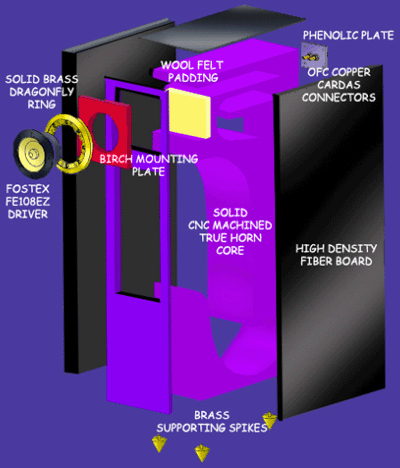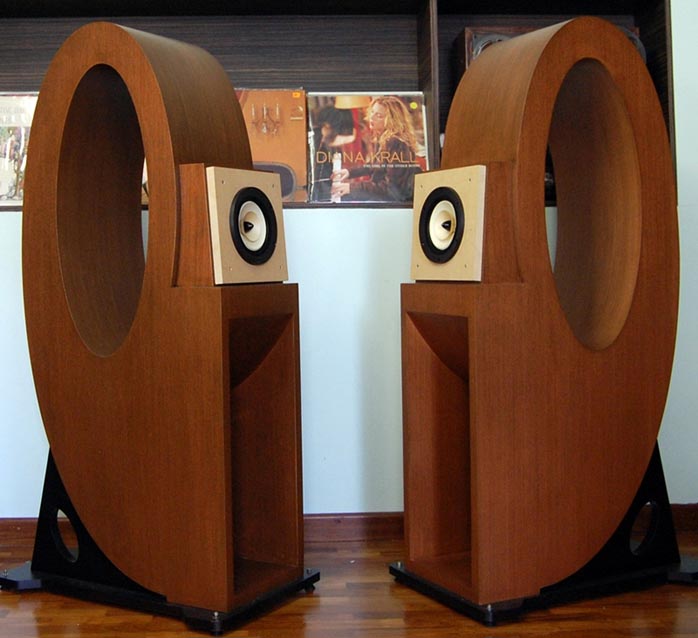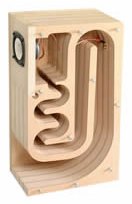No, you don't want to smooth the curves on a BLH - probably doesn't help all that much on a TL either - but let's throw that one out for debate
Not useful in a TL either.
See ya later kids
Have fun in the washington state hinterlands... be careful crossing the border.
dave
I build only one set of horns, and i am more then happy, but, need a bit more power and more bass !
Dunno about your Low Pass Filter theory, but next one gonna be prolly something like this:
Gemme Audio Concerti 108




... but calculated for bigger speaker ...
•
Dunno about your Low Pass Filter theory, but next one gonna be prolly something like this:
Gemme Audio Concerti 108




... but calculated for bigger speaker ...
•
This Gemme Audio is a step backwards from the Fostex recommended horn it is directly based on. They smoothed the passages, loosing the LP filters giving more ripple in the midrange.
A good example of seductive marketing over smart design. And the way it is executed pushed the price up into the ridiculous range.
dave
A good example of seductive marketing over smart design. And the way it is executed pushed the price up into the ridiculous range.
dave
This Gemme Audio is a step backwards from the Fostex recommended horn it is directly based on. They smoothed the passages, loosing the LP filters giving more ripple in the midrange.
A good example of seductive marketing over smart design. And the way it is executed pushed the price up into the ridiculous range.
dave
I got one question for ya .. I Googled "Fostex horn", and most of them have smooth curves - this mean people have no idea what they are doing or - what ?
I got one question for ya .. I Googled "Fostex horn", and most of them have smooth curves - this mean people have no idea what they are doing or - what ?
None of the Fostex recommended horns have smooth curves. They are all of the Olson/Nagaoka style.
Recommended Enclosures : Speaker Components : Fostex
All were designed before the advent of really good horn modeling software, and for the japanese market, so are not as good as the best of the current diy offerings. There are a large number of other horns predating good software, some are good, many could be better. Good BLH design requires a particular set of careful tradoffs... especially if you are trying to cheat size.
Check out here & here.
dave
None of the Fostex recommended horns have smooth curves. They are all of the Olson/Nagaoka style.
Recommended Enclosures : Speaker Components : Fostex
All were designed before the advent of really good horn modeling software, and for the japanese market, so are not as good as the best of the current diy offerings. There are a large number of other horns predating good software, some are good, many could be better. Good BLH design requires a particular set of careful tradoffs... especially if you are trying to cheat size.
Check out here & here.
dave
What ever dude ....
I have no idea what you talking about ...
What ever dude ....
I have no idea what you talking about ...
As with probably 90% of people that are interested in pretty back-horn speakers. Those Gemme folks and those like them produce artistically beautiful designs that make great pieces of furniture, but fly in the face of proper acoustic design. But so it is with high-end HiFi.
Bob
As with probably 90% of people that are interested in pretty back-horn speakers. Those Gemme folks and those like them produce artistically beautiful designs that make great pieces of furniture, but fly in the face of proper acoustic design. But so it is with high-end HiFi.
Bob
Oh, i understand that perfectly, I never say i am gonna buy those, i say i am gonna build similar like those !
What i don't understand how someone can just come out and say - "Those are POS" just cuz they have smooth corners inside horn ??????
He keep talking about Nagaoka labyrinths recommended enclosures! Well did he read any of Nagaoka Books? If he read all of them, he must be smart guy then, those books are only on Japanese ...
He step here with claim smooth corners are BAD for backloaded horn - talking about speakers I BUILD, and this is HIS opinion, i don't see anywhere facts about this claim ...
Well, Phase Plugs, Green painted cones, OR painted dots on cones are also NEVER recommended by Fostex ...But he keep selling them ...
What ever, i have my horns, have awesome sound, and everyone who heard them want to buy them .. LoL !
•
In his words - All those builders:





... and ME :
did all wrong ....




An externally hosted image should be here but it was not working when we last tested it.

... and ME :
An externally hosted image should be here but it was not working when we last tested it.
did all wrong ....
Several of the above designes have 180 hairpin turns, even though smooth, do contribute significantly to serving as a low pass filter. If you want to see why smooth curves are not good for a BLH, imagine a front loaded smooth walled tractrix horn - real nice and well designed to let the full bandwidth through up to 6kHz or higher. Now, put the driver in reverse on that so that its back drives the smooth horn (i.e., a smooth BLH). You will get pretty good mids and highs out of it, probably almost as good as driver mounted front face out. So if you have a BLH that is smooth and straight, the same type of bandwidth will come out of the mouth and you lose the spatial and phase coherence of the single-point full range driver as a direct radiator on top because the HF's from the backside are getting out. Having a rear chamber and a smaller throat will help reduce the HF's coming out to a certain extent, but not as good as having sharp hairpin turns and corners. If you want to quantitatively see this effect put a mic at the horn mouth and do a frequency sweep - anything more than 400Hz will start muddying up the main direct radiator output.
He keep talking about Nagaoka labyrinths recommended enclosures! Well did he read any of Nagaoka Books? If he read all of them, he must be smart guy then, those books are only on Japanese ...
Originally done by Harry Olson of RCA...an American.
And proven with real designs and builds over the past 5 years by many people and the Japanese Nagaoka designs before that.
I didn't say the smooth designs are bad (some are decent) just that smoothing is counterproductive.
dave
In his words - All those builders:
did all wrong ....
Not necessarily wrong, but not taking advantage of known positive design artibutes.
1/ Only the word of the builder on the quality of this one, and at least one of the drivers used and reported to provide good results opens up a lot of questions.
2/ & 6/ out of business
3/ not a horn (a bad TL)
4/pretty, butlikely better as designed
5/ interesting, but a lot of work for something that likely gets blown away by FH3
7/pretty, but we don't know much about it except it is translam MDF woth smooth transitions
dave
Not necessarily wrong, but not taking advantage of known positive design artibutes.
OK, document this claim ... I dont care about "Your personal opinion" or "Your Understanding" ...
planet10 said:1/ Only the word of the builder on the quality of this one, and at least one of the drivers used and reported to provide good results opens up a lot of questions.
What kind of questions ????
planet10 said:2/ & 6/ out of business
So ?????
planet10 said:3/ not a horn (a bad TL)
... "DO-IT-YOURSELF HORN SPEAKER BOXES
MM kit
(PAT.)
Backloaded horn system is high sensitivity and it brings out undertone
through the long horn from back side sound of the speaker driver.
As a result, backloaded horn system provides big speakers-like
undertone and volume level even small speakers.
But conventional backloaded horn is a pseudo system such as conical horn or combination of some straight ducts. So, the systems cloud the sound due to inside standing wave.
Such shortcomings of conventional backloaded horn system were reversed by Hasehiro's MM kit series. Let's be intoxicated by a beautiful curve makes the ultimate backloaded horn sound.
That goes beyond a loudspeaker and into the realm of a wind instrument.
Exponential Curve of MM-S
In 2003, MM kit series won the Craft Category Award
at the 22nd MJ Technology of the Year... "
planet10 said:4/pretty, butlikely better as designed
Say what ?
planet10 said:5/ interesting, but a lot of work for something that likely gets blown away by FH3
Why you don't promote your business here a bit ...
planet10 said:7/pretty, but we don't know much about it except it is translam MDF woth smooth transitions
If you read my posts here you will know a bit more about this build ...
Your comments here are NOTHING but promoting your own business, and like most of guys who make money on this forum, is just snake oil talking ...
Dont bother to answer, i am out of this topic .... Cant argue with **** !
•
Whoa, komigenie, did you hear something you didn't agree with ?
What's with attacking someone you've asked advice of ?
Keep cool -----
What's with attacking someone you've asked advice of ?
Keep cool -----
Whoa, komigenie, did you hear something you didn't agree with ?
What's with attacking someone you've asked advice of ?
Keep cool -----
Asking for advice ? Where you read this ....
Topic was started about my speakers, not by me but someone who liked my build, and guy just start talking what all is wrong with my build ...
Not just mine, every build but his own product ...
You should read whole thing again ...
OK, document this claim ...
You sure are getting your back up, i'm only trying to help, that is what we are here for. Hopefully helping others learn from our mistakes. If you want to ignore that help then go for it.
I designed & built my 1st horns in the early 1980s. The pdf of Dinsdale's seminal artical on the subject is one i scanned.
When i started i thot smooth horns were a good thing too -- a side effect of most of the info on horns being for FLHs. It is only since good software modelers have appeared, and numerous builds by many people of modern Olson/Nagaoka horns, has shown that smoothness in a BLH has been shown to not be a benefit to a BLH, something Olson did in the 50s and the Japanese have been doing for a long time.
As to FH3, is is a design free for use by any diyer. Over 500 pairs have been built (an estimate), and feedback has been very positive. It takes ideas from the original FH1 (itself based on the original Buschhorn, and very much a community effort), and some 4 years of poking & prodding by a designer way better at horns than myself to come up with what has turned out to be an extremely simple, elegant, good looking, versatile, and excellent sounding speaker.
It has led to a number of manufacturers world-wide providing pairs for those without the tools, skills or where-with-all to do it themself.
I did the drawings, fund. and maintain the community website. That we do flat-paks for North America is irrelevant (i would love to see more commercal makers in the US, it would save diyers lots of shipping)
dave
Backloaded horn system is high sensitivity and it brings out undertone
through the long horn from back side sound of the speaker driver.
Only if you use a high sensitivity driver. The overall efficiency of a horn is the same as that of the driver by itself. The horn only provides gain at low frequency <400 Hz as XRK pointed out, <300 Hz even better. This means that one can get bass out of a driver that doesn't on its own produce much, and mean that you don't need to attenuate the mid-top to deal with baffle step.
But conventional backloaded horn is a pseudo system such as conical horn or combination of some straight ducts. So, the systems cloud the sound due to inside standing wave.
It only clouds the sound and has standing waves at frequencies you do not want to come out the mouth, tirning oit to be a good thing. Volume expansions at the bends act as LP filters -- something well documented if you look at well established duct physics.
Smoothing the horn extends its response at the high end resulting in mouth radiation moving in and out of phase with the same radiation of the fron tof the speakers causing ripples and time smearing of the critical midrange -- don't forget that this HF radiation from the mouth is a significant number of wavelengths behind the main signal.
dave
Dave, kimigenie knows everything because he read it on the Internet. You only have the limited knowledge of actually building the the d@mn things. Let him go.
Bob
Bob
Not just mine, every build but his own product ...
My own product? None of the Nagaoka horns are mine, none of the Spawn horns either. I do get someside benefit from FH3, but that is detailed in an eatlier post.
All of these designs were/are diy driven, many a diyer has been able to derive great musical satisfaction from having access to these designs (the great majority of which are freeky available -- do not try to attribute a profit motive to them).
dave
Dave, kimigenie knows everything because he read it on the Internet. You only have the limited knowledge of actually building the the d@mn things. Let him go.
Thanx Bob, good advice.
The great number of people quietly watching are likely the greatest beneficiaries of this exchange.
dave
- Status
- Not open for further replies.
- Home
- Loudspeakers
- Full Range
- Cabinet in layers